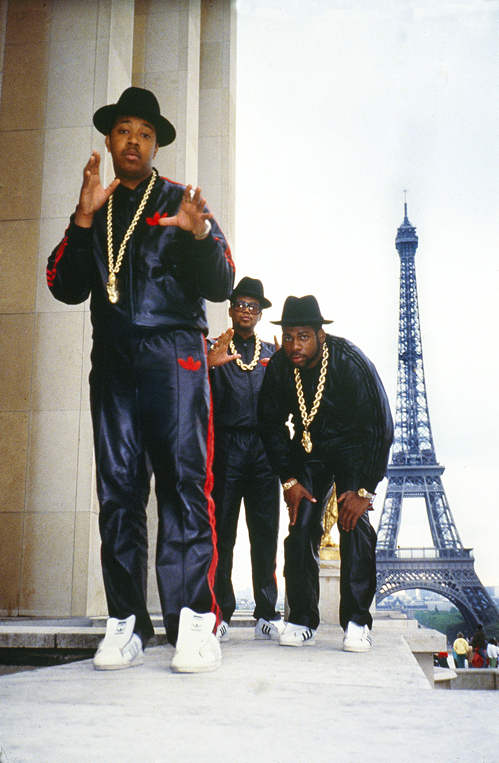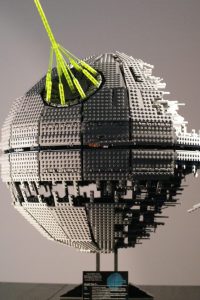
Adidas shoes have always been promoted as shoes for athletes. Non-athletic city inhabitants were not planned as a target group in the brand’s strategy. Over the first decade since their premiere in 1969, Adidas Superstars were popular among basketball players, but in 1983 the true idols of the street at that time – hip hop group Run-D.M.C. – started to add their two pence to the number of pairs sold (translating into millions on the brand’s account).
Run-D.M.C. gained popularity in the 1980s thanks to their own image idea. They stood out among other hip hoppers mainly because they wore on stage the same they would wear on the street, promoting the style close to the hearts of youths from the black districts of New York: tracksuit and sports shoes (in their case Adidas Superstar – white kicks with three stripes on the side). This won the hearts of the audience, for whom it was easier to identify with the musicians. Other hip hop stars, performing in over-styled attires, coats and leather, were kicking themselves.
Adidas representatives most probably weren’t aware of this free advertising. Maybe they didn’t even relate the increase in Superstar sales with Run-D.M.C. US tour at that time. Being an underground and fledgling phenomenon, hip hop had not yet attracted large concerns. Meanwhile, the environment of hip hoppers and b-boys (breakdancers) had its own very unique style and formed a large market for sports shoes and clothing.

The trend promoted by Run-D.M.C. – sneakers without shoe laces and with the tab pulled out – was a reference to the way prisoners wore their shoes. In 1985 the song “Felon sneakers” by Jerrald Deas described young people wearing sneakers as the ones who are problematic and often end up in jail (quote: We’re gonna tell you about a few felony cases/ it started with the brothers wearing fat shoe laces […] If an unlucky brother winds up in jail/his felon sneakers can’t get him bail). As a response to it Run-D.M.C. published in 1986 its single “My Adidas” as a tribute to their beloved kicks and trying to reverse the harmful b-boy stereotype (quote: I wore my sneakers but I’m not a sneak/ My Adidas cuts the sand of a foreign land/ with mic in hand I cold took command/my Adidas and me, close as can be).
Apparently, the song wasn’t written gratuitously. The musicians were talked into writing it by Russell Simmons, promoter who realized the potential of the Aididas mania going on around the band. That same year Run-D.M.C.’s concert at the Madison Square Garden was attended by Adidas employee Angelo Anastasio. The businessman surely was impressed by the view of 40 thousand fans holding up their shoes. Of course, it was right after the first sounds of “My Adidas” came out of the speakers. Inspired by what he saw, Anastasio hurried to Adidas New York main office and soon the first ever advertising contract between a large concern and a hip hop group was signed. It amounted to USD 1 million. The success came instantly: with a shell toe sneakers “Superstars” limited edition followed by a clothing line that has been in production till this day. Many years later the shoes are still popular and have had many re-editions, e.g. for the 35th birthday of Superstars, when models dedicated to 25 cities (mind: not 25 basketballers) and to Run-D.M.C. were designed. What’s more, it is believed that the cooperation marked the birth of the powerful and inseparable marketing relation between two worlds: music and fashion.
The story of Adidas and Run-D.M.C. shows that when thinking about a product it is worth going beyond your well-known market; to break the business pattern and search for new, non-obvious opportunities. Maybe the demand for your technology/service is also in other market areas, other target group. It’s good to listen to the crowd. It is very often the users who tell you what they need and by observing them – what they are and what they’re interested in – can bring you ideas for telling your marketing story differently. When LEGO company was founded the production of wooden toys was only part of its activity. Their success among customers eventually made them the main profile of the company. It later turned out that also adults were fond of building constructions with blocks. Lego continued to expand their offer, thinking about customers from gradually older target groups and with more and more precised area of interests (e.g. LEGO Ultimate Collector Series for “Star Wars” fans).

The inspiration very often comes from culture: films, books, music (as the example of Run-D.M.C. proves). After all, this is the world that is best at guessing people’s dreams or even projecting the future. Nike spent years on developing self-tying sneakers – similar to those we could watch in “Back to the Future II” cult movie with its vision of the world in 2015. Here’s the end of 2016 when the Nike HyperAdapt eventually is launched onto the market (as elite product, which excites fans even more). For most people they’re just a perfect movie gadget, but the brand has thought about helping those in need: the HyperAdapt are orthopedic footwear responding to the needs of people with physical disability (e.g. suffering Parkinson’s disease) – anyone who is not able to tie shoe laces by themselves.
Pay attention to who uses your product and how. Who else could use it. Search for new challenges, solve problems. Try to discover the potential in audience you hadn’t focused on in advertising so far. Think about what you might do to meet their needs as well. Adidas shoes soon ceased to be a product for a narrow group of athletes, as thousands of people in the streets started to make use of them, too.
Kategorie: power of contentic, B2C